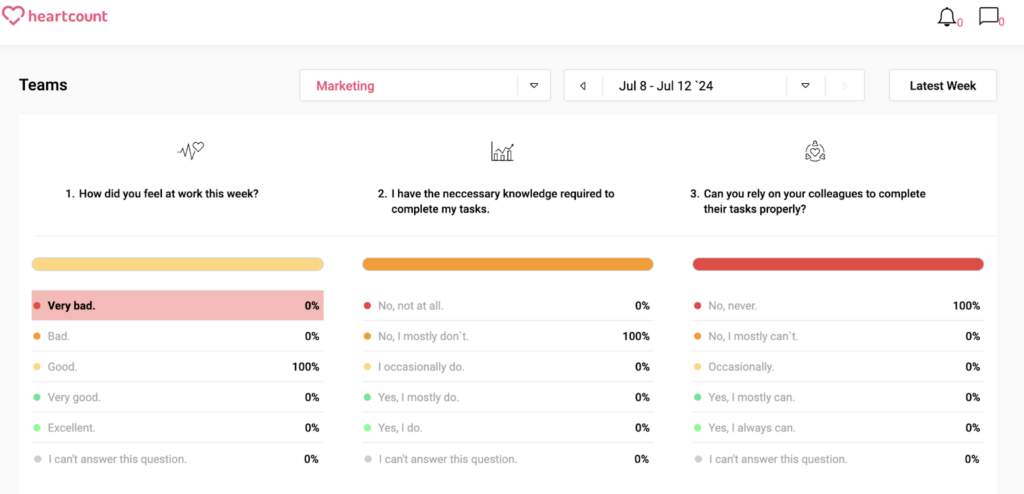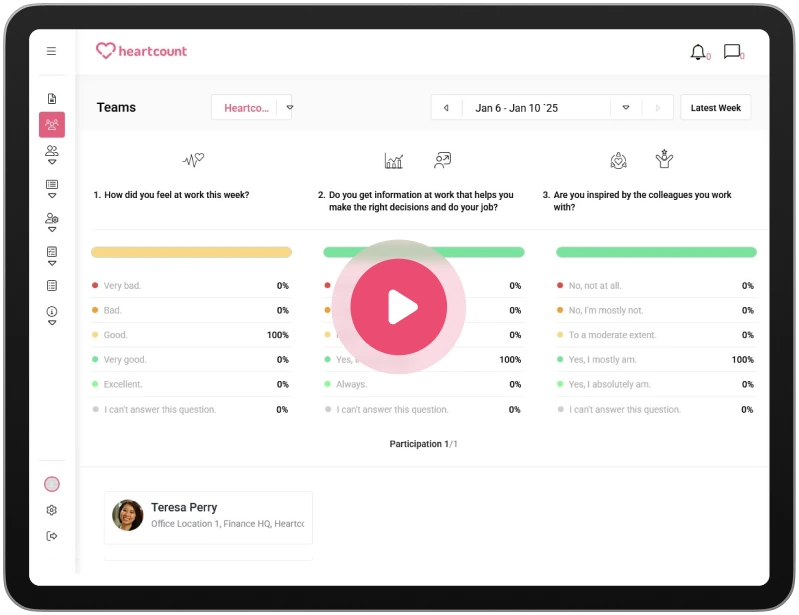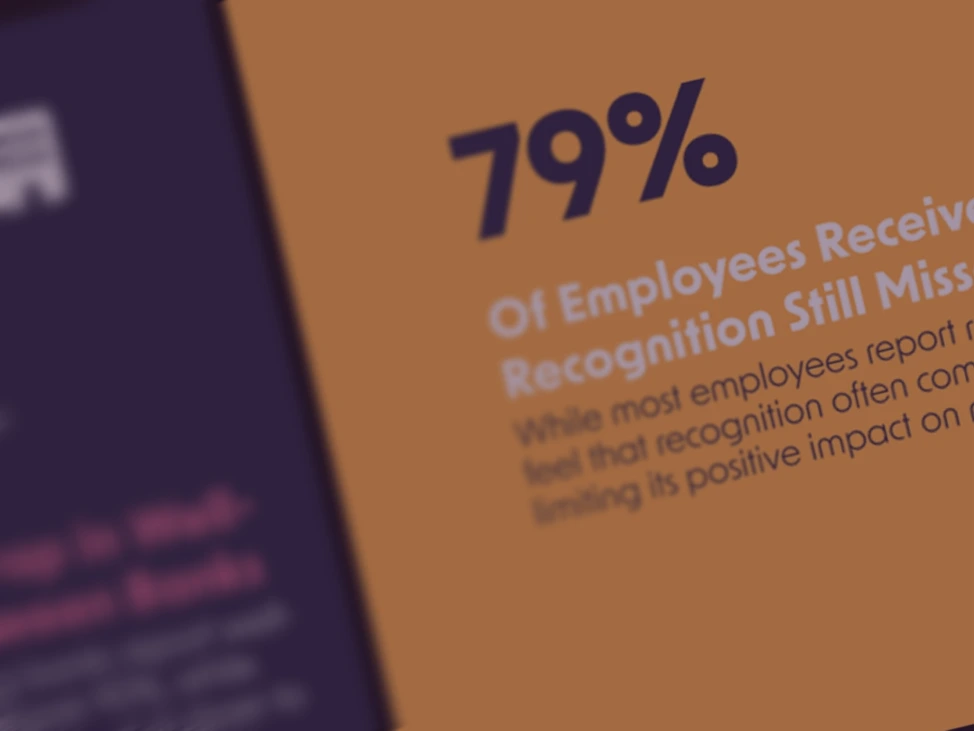The benefits of employee engagement

Imagine you’ve noticed one of your employees has become withdrawn at work. He no longer contributes during team meetings and frequently misses deadlines. Colleagues notice his lack of interest and engagement during interactions.
As a result, team dynamics suffer, leading to delays in project timelines and a decline in overall productivity. This situation not only affects internal operations but also directly impacts customer satisfaction.
Engaged employees produce better business outcomes and are more likely to stay with their employers. Employee engagement directly affects employee retention, profitability, and productivity. For that reason, modern companies focus on improving and measuring employee engagement.
Imagine you’ve noticed one of your employees has become withdrawn at work. He no longer contributes during team meetings and frequently misses deadlines. Colleagues notice his lack of interest and engagement during interactions.
As a result, team dynamics suffer, leading to delays in project timelines and a decline in overall productivity. This situation not only affects internal operations but also directly impacts customer satisfaction.
Engaged employees produce better business outcomes and are more likely to stay with their employers. Employee engagement directly affects employee retention, profitability, and productivity. For that reason, modern companies focus on improving and measuring employee engagement.
What is employee engagement?
Employee engagement refers to the level of enthusiasm employees have toward their company. It can show you how emotionally invested they are in the organization’s success. Engaged employees are passionate about their work and motivated to perform better. You can notice their commitment to the job and willingness to collaborate and contribute with new ideas.
Disengaged employees often lack interest or excitement about their job responsibilities. This results in lower productivity, higher turnover rates, and even harm to company culture. To prevent this, it’s essential to constantly seek new engagement ideas to keep your team motivated from day one.
Levels of engagement
Depending on how employees perceive their workplace, we categorize employee engagement into four levels:
1. Actively engaged
Actively engaged employees are curious about the organization’s goals and values and consistently achieve high productivity levels, leveraging their talents, strengths, and knowledge daily. They take initiative, work passionately, drive innovation, and propel the organization forward.
2. Engaged
Engaged employees possess a solid amount of motivation and can independently perform tasks. They often leverage their strengths and knowledge at work, and they are more likely to stay with the company. They feel that their work is appreciated and are satisfied with their relationships with management and co-workers.
3. Disengaged
Disengaged employees usually focus on checking off their tasks without much thought about their work’s meaning and broader goals. They often feel disconnected from the company’s goals and values and feel that their contributions are overlooked.
4. Actively disengaged
Actively disengaged employees openly confront the organization and its goals. They may spread negativity, complain frequently, and undermine their colleagues’ efforts. Their attitude and behaviour can significantly lower team morale and create a toxic work environment. Actively disengaged employees are most likely to leave the company shortly.
Top 7 benefits of employee engagement
According to Gallup’s State of the Global Workplace: 2024 Report, 62% of the US workforce isn’t engaged.
The low engagement costs the global economy US$8.9 trillion, or 9% of the global GDP.
Why should you care about this?
These figures show the importance of maintaining a high level of employee engagement for overall business growth and stability.

The benefits of engaged employees can be seen in the following:
1. Employee productivity
When employees are engaged, you can trust that they will fulfil their responsibilities and meet deadlines without constant supervision. They are intrinsically motivated to contribute, believing their efforts can make a difference in your organization.
Highly engaged employees aren’t just 14% more productive than those with low engagement, they also have a positive attitude toward the company and act as a true ambassadors.
They feel appreciated, so they are motivated to give it their all. That means they work harder, take shorter breaks, and waste less time. This dedication boosts their productivity, powering the company’s achievement.
2. Employee retention and turnover rate
Employees who are engaged tend to be more committed to their jobs and less likely to leave the company. Moreover, research shows that engaged business units experience 18% less turnover in organizations with high turnover rates.
By prioritizing employee engagement, you not only create a happier workforce and reduce turnover but also attract top talents.
3. Improved work quality
If you have an engaged workforce, you can count on them to understand your organizational goals and how they fit into the bigger picture. This sense of ownership leads to greater accountability, improving individual and team performance.
Moreover, employees who are fully engaged in their roles demonstrate higher dedication.
Thanks to their strong alignment with the company’s mission, they will deliver high-quality work and offer more innovative and creative solutions.
4. Lower absenteeism
Did you notice your employee’s frequent absences from work without cause?
Absenteeism is one of the factors that indicate a disengaged employee. Gallup research shows that engaged employees experience an 81% lower absenteeism rate.
Here’s the thing. When the job doesn’t provide satisfaction and fulfillment, employees are more likely to avoid it. This absence costs companies 225.8 billion dollars annually due to hiring replacements, paying overtime, and managing downtime.
6. Improved customer service
Customers often form opinions about a company based on their interactions with employees.
Imagine you purchase something online, but the item doesn’t arrive within the estimated time frame. Frustrated, you contact customer support to get information about the delay.
The dissatisfied agent responds: “Delays happen. It’s not my fault your package is late. There’s nothing I can do about it right now.”
In the example, the customer support agent is clearly disengaged, and his attitude toward the job negatively affects customer satisfaction.
Instead of helping you resolve the issue and ensure satisfaction, their response makes you even more frustrated. This interaction leads you to reconsider ordering from this company in the future.
So, dissatisfied employees may convey their frustration to customers. On the contrary, an engaged workforce achieves 10% higher customer loyalty scores and delivers better customer experiences.
7. Increase in profitability
An engaged workforce is 23% more profitable than those with low engagement levels. Increased profitability stems not only from being more productive and effective at work but also from employees’ overall commitment to the company.
Firstly, engaged employees are less likely to take unnecessary absences, which reduces absenteeism costs for the organization.
Secondly, lower turnover rates among engaged employees result in reduced recruitment, hiring, and training expenses associated with replacing staff.
Additionally, engaged employees tend to present the company in a positive light and build strong client relationships. Satisfied clients are more likely to return for future purchases and recommend the company to others.
All these factors directly contribute to improved profitability.
How to measure employee engagement?
A survey is one of the best ways to measure employee engagement levels.
An employee survey provides valuable insights into your staff’s satisfaction. This helps you identify areas for improvement and make an action plan. Also, it will help you address communication, workload, and work-life balance.
Besides, employee engagement surveys can provide clear insight into employee sentiment and any other factors that may affect engagement.
That’s why top businesses create initiatives like flexible work arrangements and recognition programs. These efforts build emotional connections between staff and their workplace.
How to conduct an employee engagement survey?
Here’s how you can get started:
- Identify the purpose and goals. What do you want to achieve with your engagement survey? You may want to measure engagement or identify areas to improve.
- Choose the best survey method for your organization. It may be an online survey, in-person interview, or focus group.
- Develop a set of questions. Questions should measure engagement levels and determine what drives employee satisfaction.
- Ensure confidentiality and anonymity of responses to encourage honest employee feedback.
- Communicate the importance of the survey. Encourage employee participation to ensure accurate and representative results.
- Analyze the results. Identify areas for improvement based on response data.
- Create an action plan. Address identified areas for improvement and communicate progress updates with employees.
With HeartCount Pulse Check, you can receive data on eight categories of employee engagement on a weekly or biweekly basis.
Your employees will automatically receive a short survey every Friday at 11 AM. This time is strategically chosen to reflect on the past week and maximize the survey response rates.
The survey model is proven by science and has 140 questions that measure employee engagement.

Use survey results to develop an employee engagement strategy
It’s not enough to measure how your employees feel or how engaged they are. You have to take action based on the information you receive and identify an engagement initiative that will work for you.
Yet, don’t approach things ad hoc. The key is to create an effective employee engagement strategy based on real-time data from your employees.
Here’s a list of steps to keep in mind:
- Analyze the survey results. Once you’ve collected all the data, analyze it to identify strengths and weaknesses.
- Identify engagement drivers. Use the survey results to determine what motivates your employees to work harder and engage more in their work.
- Develop effective strategies. Based on your analysis, create actionable strategies that address areas of improvement.
- Establish an action plan. Create an engagement action plan that outlines specific steps for improving employee engagement.
- Share results with leadership. Report your findings to your leaders and stakeholders. This is an essential part of your ongoing effort to improve continually.
HeartCount’s intuitive dashboard lets you track employee engagement and monitor your strategy.

The role of leadership in driving employee engagement
Effective leadership is essential for building engaging employees and promoting motivation and engagement.
As a leader, you can build an emotional bond between employees and the organization by creating a culture of trust, respect, and open communication. Their efforts can also build camaraderie within teams, leading to higher job satisfaction and morale.
Conclusion
By making your staff happy, you can boost their productivity and your business’s revenue. Nowadays, there are various employee engagement platforms that can help you achieve this effortlessly.
For example, with HeartCount, you can monitor engagement levels in real time and take proactive steps to improve them before issues escalate. Start a free trial today to see how!








